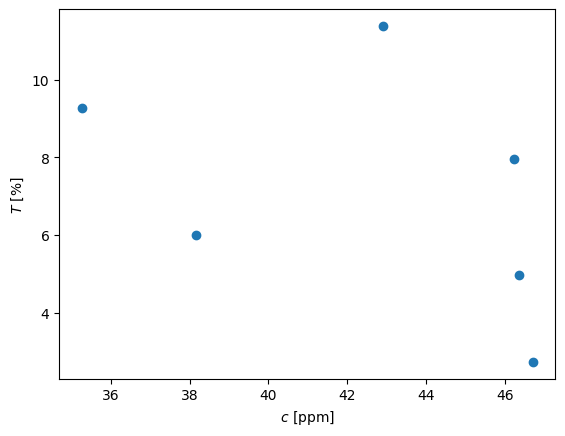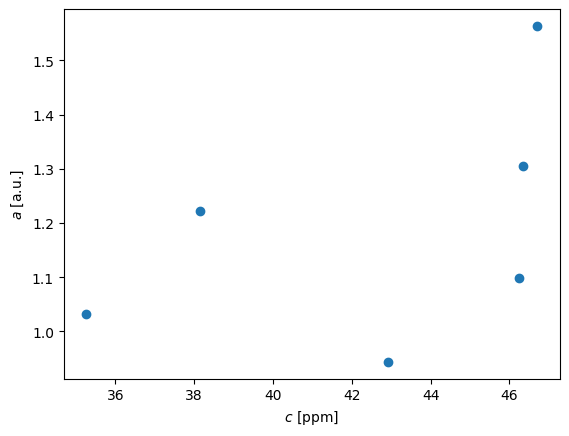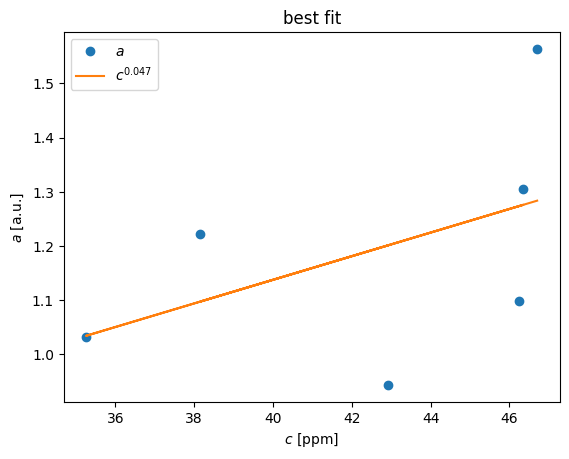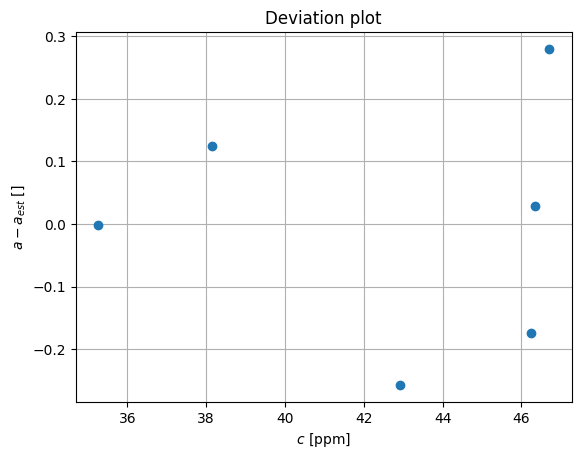Homework no. 1 example#
Use of static calibration curve and estimate of uncertainty.
Measure several (at least 3) calibration points and fit a regression line to the calibration curve.
Linear calibration curves are desirable because they result in the best accuracy and precision. If the data is non-linear, try logarithmic approach
A plot of the calibration data and the fitted line should always be examined to check for outliers and to verify linear behavior.
In this example we use the residuals to calculate standard errors of the point estimates. The assumption is that the noise is uniform and random and it’s not always a valid one.
Example 1#
Given: The following data was obtained in the analysis of concentration of a solute using spectroscopy.
Required: Following calibration, a sample of concentration was analyzed and the measured transmittance was 35.6%. Report the concentration of analyte in the form of a confidence interval.
import numpy as np
import pylab as pl
# x = np.sort(np.random.rand(5,1)*55)
# y =
# c = np.array([5.1, 17.0, 25.5, 34.0, 42.5, 51.0 ]) # concentration [ppm]
# T = np.array([78.1, 43.2, 31.4, 18.8, 14.5, 8.7]) # transmittance, [%]
c = np.sort(np.random.rand(6,1)*55,axis=1)
krand = np.random.rand(1)*0.05
T = 100*10**(-(c*krand + krand/10))+np.random.rand(6,1)*10
pl.plot(c,T,'o')
pl.xlabel('$c$ [ppm]')
pl.ylabel('$T$ [%]')
Text(0, 0.5, '$T$ [%]')

First we need to convert the transmittance into absorbance. Absorbance is known to be proportional to concentration. The translation is according to \(a = -log(T/100)\)
a = -np.log10(T/100)
pl.plot(c,a,'o')
pl.xlabel('$c$ [ppm]')
pl.ylabel('$a$ [a.u.]')
Text(0, 0.5, '$a$ [a.u.]')

Regression analysis#
Following the recipe of http://www.answermysearches.com/how-to-do-a-simple-linear-regression-in-python/124/
from math import sqrt
# define the new function
def linreg(X, Y):
"""
Summary
Linear regression of y = ax + b
Usage
real, real, real = linreg(list, list)
Returns coefficients to the regression line "y=ax+b" from x[] and y[], and R^2 Value
"""
if len(X) != len(Y): raise ValueError('unequal length')
N = len(X)
Sx = Sy = Sxx = Syy = Sxy = 0.0
for x, y in zip(X, Y):
Sx = Sx + x
Sy = Sy + y
Sxx = Sxx + x*x
Syy = Syy + y*y
Sxy = Sxy + x*y
det = Sxx * N - Sx * Sx
a, b = (Sxy * N - Sy * Sx)/det, (Sxx * Sy - Sx * Sxy)/det
meanerror = residual = 0.0
for x, y in zip(X, Y):
meanerror = meanerror + (y - Sy/N)**2
residual = residual + (y - a * x - b)**2
RR = 1 - residual/meanerror
ss = residual / (N-2)
Var_a, Var_b = ss * N / det, ss * Sxx / det
#print "y=ax+b"
#print "N= %d" % N
#print "a= %g \\pm t_{%d;\\alpha/2} %g" % (a, N-2, sqrt(Var_a))
#print "b= %g \\pm t_{%d;\\alpha/2} %g" % (b, N-2, sqrt(Var_b))
#print "R^2= %g" % RR
#print "s^2= %g" % ss
return a, b, RR
K,b,RR = linreg(c,a)
print (K,b,RR)
[0.02177343] [0.26672094] [0.22628358]
a_est = c*K+b
pl.plot(c,a,'o',c,a_est)
pl.xlabel('$c$ [ppm]')
pl.ylabel('$a$ [a.u.]')
pl.title('best fit')
pl.legend(('$a$','$c^{0.047}$'),loc='best')
<matplotlib.legend.Legend at 0x77e04e5504d0>

pl.plot(c,a-a_est,'o')
pl.grid(True)
pl.xlabel('$c$ [ppm]')
pl.ylabel('$a - a_{est}$ []')
pl.title('Deviation plot')
Text(0.5, 1.0, 'Deviation plot')

Now we estimate the value from the measurement, using calibration curve
T1 = 35.6# percent transmittance
a1 = -np.log10(T1/100)
# a = c*0.047+0.0115
c1 = (a1 - b)/K
print (c1)
[8.35096248]
Now we can assuming random white noise estimate the confidence level:
dev = a-a_est
print (dev)
stdev = np.mean(dev**2)**0.5
print( "We can estimate the concentration of the sample as: %6.4f with uncertainty %6.4f" % (c1, stdev))
[[ 0.27983781]
[ 0.12435718]
[-0.17396999]
[ 0.02842436]
[-0.0013944 ]
[-0.25725495]]
We can estimate the concentration of the sample as: 8.3510 with uncertainty 0.1784
/tmp/ipykernel_276671/2840785504.py:5: DeprecationWarning: Conversion of an array with ndim > 0 to a scalar is deprecated, and will error in future. Ensure you extract a single element from your array before performing this operation. (Deprecated NumPy 1.25.)
print( "We can estimate the concentration of the sample as: %6.4f with uncertainty %6.4f" % (c1, stdev))
More accurate assessment of uncertainty is using the t-distribution and updated standard deviation for small samples, we learn it later.
Sxx = 5*np.var(c)
cmean = np.mean(c)
stdev1 = stdev/K*np.sqrt(1+ 1.0/6.0 + ((c1-cmean)**2)/(5*Sxx) )
t = 2.7764 # for 97.5% confidence interval and 5 samples (n-1)
print ("We can estimate the concentration of the sample as: %6.4f with uncertainty %6.4f" % (c1, stdev1*t))
We can estimate the concentration of the sample as: 8.3510 with uncertainty 42.9059
/tmp/ipykernel_276671/3575188156.py:5: DeprecationWarning: Conversion of an array with ndim > 0 to a scalar is deprecated, and will error in future. Ensure you extract a single element from your array before performing this operation. (Deprecated NumPy 1.25.)
print ("We can estimate the concentration of the sample as: %6.4f with uncertainty %6.4f" % (c1, stdev1*t))
